There are 16 species of turtles in Pennsylvania, 14 native turtles, and 2 introduced species. There are endangered turtles, land dwellers, large Snapping turtles, and small mud turtles.
Pennsylvania has a rich history. It was and still is a very important state when it comes to Presidential elections, the state produces more mushrooms than any other state, and most importantly, it’s home to Hershey’s. What’s better than chocolate?
If you’re looking for a native Pennsylvania turtle to own, be sure to check out the state’s laws on owning turtles. Some species are illegal to own, and many expensive turtles get poached from the wild to be sold. Turtles taken from their natural habitat don’t do well in captivity and often lead to premature death.
Look for an upstanding, well known breeder for your next pet turtle. It will be healthier, better cared for, and will be a lasting companion.
Now, let’s find out what turtles live in Pennsylvania, shall we? Once we are done, I say let’s celebrate with a big bar of chocolate!
Table of Contents
Turtles in Pennsylvania
1. Blanding’s Turtle

- Experience Level: Intermediate
- Family: Emydidae
- Scientific Name: Emydoidea blandingii
- Other Names: N/A
- Adult Size: 5 to 8 inches (12.5 to 20 cm)
- Life Span: Up to 80 years
- Average Price Range: $300 to $450
- Conservation Status: Endangered
Our first shelled reptile is a medium sized, endangered species. The Blanding’s turtle lives in marshes, bogs, and other similar wetlands. Unfortunately, these habitats are quickly getting drained and developed, and this process is taking these turtles with it.
Blanding’s turtles have dark shells with faint, yellowish speckles. If you see this turtle before it dives underwater, you’ll probably see the bright yellow chin and throat. Upon further inspection, you may also see that this turtle seems to have a permanent grin attached to its face.
This “turtle that smiles” is rather popular in the pet trade because of its cheery demeanor. Poaching is another human habit that puts strain on these turtles.
Unlike most mammals and birds, turtles don’t reach sexual maturity until they are 15 to 20 years old, then when they lay eggs, the nests get raided by predators. Hatchlings are also easy targets for raccoons, snakes, birds, and many other larger animals.
When turtles are removed from the landscape, it could take generations before their numbers become stable again.
Blanding’s turtles are omnivorous and will feed on crustaceans, insects, leeches, fish, worms, and mollusks. They will also consume many of the plants found in their habitat.
2. Bog Turtle
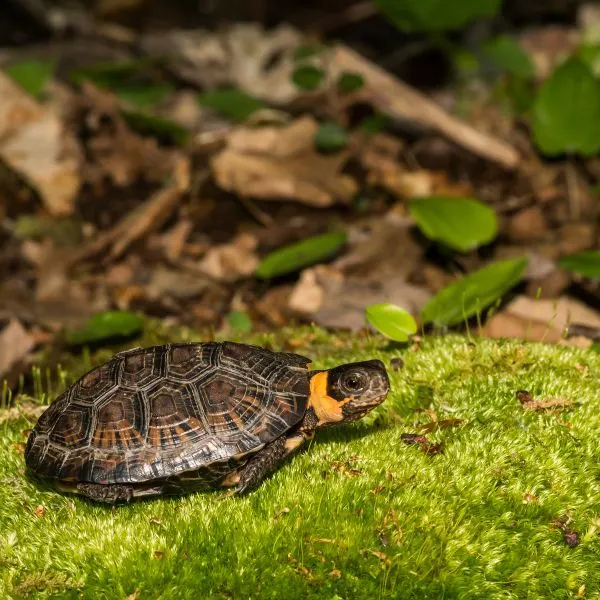
- Experience Level: *Expert
- Family: Emydidae
- Scientific Name: Glyptemys muhlenbergii
- Other Names: Muhlenberg’s turtle
- Adult Size: 3.5 to 5 inches (9 to 12.5 cm)
- Life Span: Up to 60 years in the wild
- Average Price Range: Illegal to own, Federally protected species
- Conservation Status: Endangered
Another turtle that is reliant on wetlands, marshes, swamps, and other similar landscapes, the tiny Bog turtle is critically endangered. It’s also a highly poached species. If poachers find a population in the wild, they could easily remove the entire family in a short time.
These turtles are federally protected, and it’s illegal to own them.
Bog turtles are the smallest species in North America. You can recognize them by the slightly raised ridge on the upper shell (called the carapace). The shell is dark brown to black and may have a faint starburst pattern.
The easiest way to identify these turtles is by the reddish, or orange patches just behind the eyes. They can be separate blotches or connected and look like a rind around the head.
These turtles are also omnivores that feed on small invertebrates such as mollusks, worms, insects, and plants.
Box Turtles in Pennsylvania
3. Eastern Box Turtle

- Experience Level: Beginner
- Family: Emydidae
- Scientific Name: Terrapene carolina carolina
- Other Names: Land Turtle
- Adult Size: 4 to 7 inches
- Life Span: 50 to 100 years
- Average Price Range: $260 – $360
- Conservation Status: Michigan, New Hampshire, Massachusetts, and Connecticut—list the animal as a species of special concern, and Maine lists the turtle as endangered.
Eastern Box turtles can be found throughout Pennsylvania except for the extreme northern areas of the state. Woodlands, forests, and some grasslands are preferred habitats for this turtle.
A terrestrial species, the Eastern Box turtle rarely ever completely submerges itself in water, they will sometimes soak in shallows or small puddles though. They prefer to burrow under damp leaf litter, or rotting wood to maintain the proper humidity levels.
Box turtles roam grasslands or the forest floor, but they rarely ever travel far from their original birth site.
The Eastern Box turtle has a dark brown, or olive colored, highly rounded shell. The scutes or growth plates are all decorated with yellow, or orangish markings that are as individual as fingerprints. The scales and skin are the same colors as the shell.
When they are threatened, Box turtles can pull themselves into their shells, and close them up tightly. Few turtle species can do this, as most—especially aquatic turtles—have a fixed, unhinged bottom shell (plastron).
These turtles are omnivorous scavengers. They will feed on carrion, plants, berries, insects, mushrooms, seeds, worms, snails, slugs, and eggs.
Cooters in Pennsylvania
4. Northern Red-bellied Cooter
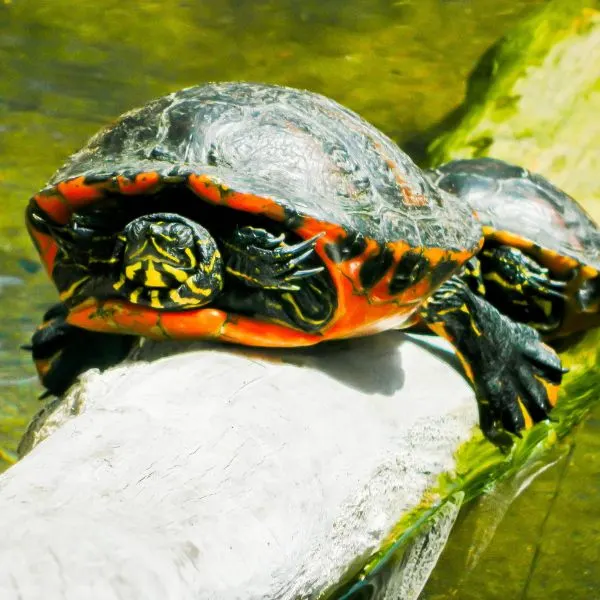
- Experience Level: Beginner to Intermediate
- Family: Emydidae
- Scientific Name: Pseudemys rubriventris
- Other Names: American red-bellied turtle
- Adult Size: Between 8 and 12 inches
- Life Span: Between 40 and 55 years
- Average Price Range: Between $30 and $170
- Conservation Status: Near threatened
Northern Red-bellied Cooters are found in a few southern counties in Pennsylvania. They like to inhabit ponds, lakes, rivers, and streams with sandy or otherwise soft bottoms. Occasionally this turtle can be found in brackish water, but they need to return to fresh, non-salty water.
These turtles have a more streamlined shell. It’s dark colored, brown, olive, or nearly black, but the bridge and plastron are bright red. The exposed skin is dark colored but has yellow stripes all about it.
Northern Red-bellied Cooters love to bask. They usually feed in the mornings and then spend much of the daylight hours basking on logs, brush piles, rocks, and river banks.
These turtles feed on nearly anything in their habitat, but they have to swallow their food in the water. They will eat crustaceans, fish, insects, and plants.
Map Turtles in Pennsylvania
5. Northern Map Turtle
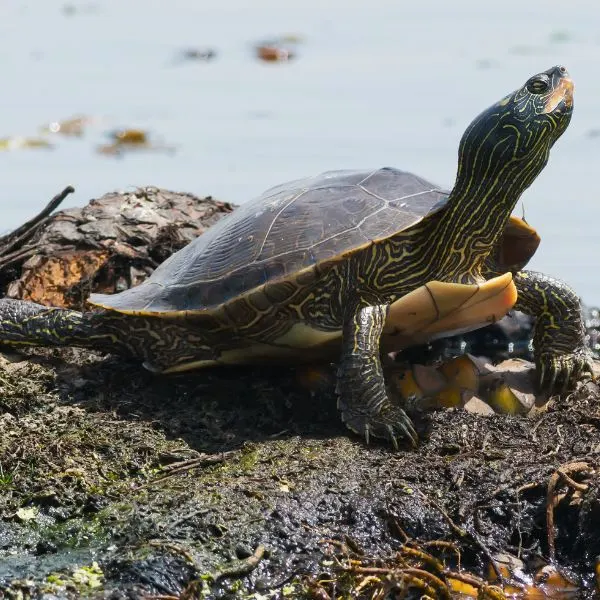
- Experience Level: Beginner
- Family: Emydidae
- Scientific Name: Graptemys geographica
- Other Name: Common map turtle
- Adult Size: Between 4 and 10 ½ inches
- Life Span: 15 to 20 years
- Average price range: Between $20 and $60
- Conservation Status: Least concern
Although they are fairly common across much of North America, Northern Map turtles are only found in small pockets in the east, west, and central Pennsylvania. They inhabit lakes, rivers, and large bodies of water.
You may never see these turtles even if they are numerous in your area. They love to bask, but these elusive and shy turtles will quickly escape into the water at the slightest disturbance. Often they congregate in large numbers, but they always stay very alert, and when they see anything, all of them will disappear and stay submerged.
If you can see these turtles, you’ll see an olive, to dark brown carapace with a slight ridge along the middle. They also have a serrated back end on the shell, but these characteristics fade as the turtle gets older.
They also have a yellowish webbed pattern on the shell, along with dark skin and white, yellow, or green stripes. Females are much bigger than males of the same species.
Northern Map turtles are mostly carnivorous. Females feed on crayfish, freshwater clams and mussels, and fish, while the smaller males tend to eat snails and insects.
Mud Turtles in Pennsylvania
6. Eastern Mud Turtle

- Experience Level: Beginner
- Family: Kinosternidae
- Scientific Name: Kinosternon subrubrum
- Other Names: Common mud turtle
- Adult Size: 3 to 4 inches
- Life Span: 40 to 50 years
- Average Price Range: $20 – $100
- Conservation Status: Least concern
Eastern Mud turtles like to live in shallow, still waters such as ponds, swamps, bogs, and drainage ditches. They need water with copious amounts of plants and muddy, or soft substrate.
These Mud turtles are only found in southeast counties. Another shy turtle, they will stay underwater, or bury themselves in the mud when threatened. They can also close themselves in their shells because they have hinged plastrons like Box turtles.
Eastern Mud turtles have oval shaped shells that are solid colored. When they aren’t covered in mud, you’ll see a brown, yellowish, or nearly black shell.
Their skin is dark grey, olive, or brown with some darker speckling.
These turtles are omnivores but prefer to eat mollusks, crustaceans, insects, and tadpoles.
Musk Turtles in Pennsylvania
7. Eastern Musk Turtle
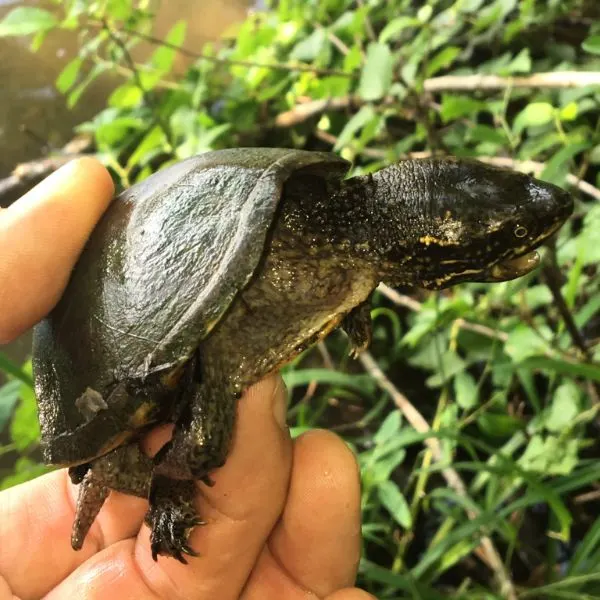
- Experience Level: Intermediate
- Family: Kinosternidae
- Scientific Name: Sternotherus odoratus
- Other Names: Common Musk turtle, Stinkpot
- Adult Size: 4 to 5 inches
- Life Span: 30 to 50 years
- Average Price Range: $30 to $120
- Conservation Status: Least concern
Our next small turtle can be a little stinker. The Eastern Musk turtle has glands located at the back of their shell that can assault the senses, especially the nose. When threatened, or if they are feeling rather ornery, they can release the musk from these glands.
They are also called Stinkpots because of this trait. The Eastern Mud turtle can do the same thing, but they are a bit more discerning with their musk glands.
Eastern Musk turtles prefer the same type of water as our previous entrant and can look quite similar to the Mud turtle. They have a similarly shaped shell, but if you look at the head (don’t get too close because they may try to bite) you’ll see two pairs of white stripes on either side of the head.
Another amazing trait these turtles are known for is their ability to climb. When trees have low hanging branches, these little stinkers may crawl up and hang out in the tree. Like an excited 6-year old, they will search the branches for insects, spiders, and other invertebrates.
Stinkpots are omnivores. They eat the items listed above as well as plants, tadpoles, snails, and unwary fish.
Painted Turtles in Pennsylvania
8. Eastern Painted Turtle
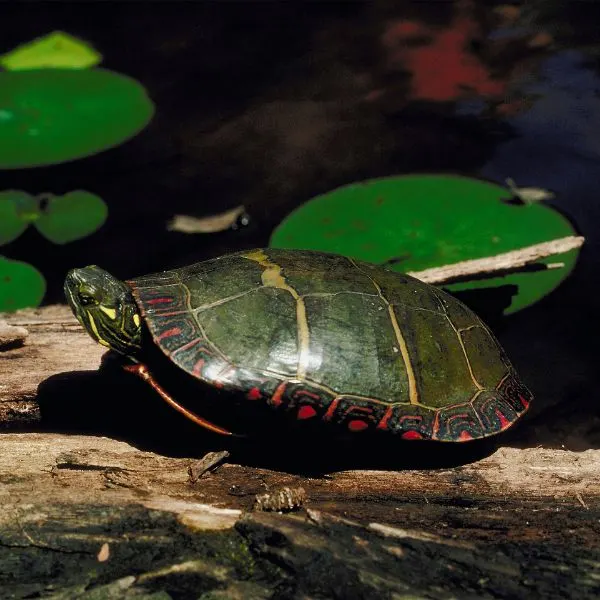
- Experience level: Beginner
- Family: Emydidae
- Scientific Name: Chrysemys picta
- Common Name: Painted Turtle
- Average Adult Size: 4 – 10 inches
- Life Span: 30 – 50 years
- Average Price Range: Between $30 to $150
- Conservation Status: Least Concern
There are 4 subspecies of Painted turtles, and they all look very similar to each other. Eastern Painted turtles have smooth carapaces and scutes that align to form straight lines. The plastron is yellowish and has no markings. Other subspecies usually have some type of pattern on the bottom.
These turtles have olive, or nearly black skin with yellow, orange, and sometimes red stripes. They usually have two yellow patches behind and under the eyes.
Eastern Painted turtles prefer slow moving waters such as streams, ponds, and marshes. They need an area with a variety of plants to hide, hunt among, and feed on.
Juvenile Eastern Painted turtles feed mostly on insects and other protein sources, while adults have a more varied diet, and will consume more plant matter than young Painted turtles.
9. Midland Painted Turtle

- Experience Level: Beginner
- Family: Emydidae
- Scientific Name: Chrysemys picta marginata
- Other Names: N/A
- Adult Size: Between 4 and 10 inches
- Life Span: Between 30 and 50 years
- Average price range: Between $30 and $150
- Conservation Status: Special concern
The Midland Painted turtle has a streamlined carapace that is smooth, dark green, or dark brown. On the underside, you’ll see a tan to yellowish color with a darker pattern along the midline.
Other than that, it’s difficult to tell them apart from other Painted turtle species.
They often overlap habitats with Eastern Painted turtles, and both are found across Pennsylvania. They look for still waters with an abundance of basking spots. Unlike most turtles, the Midland Painted turtle is very tolerant of pollution.
Midland Painted turtles feed mostly on insects and snails, but they will also feed on algae and plants.
Snapping Turtles in Pennsylvania
10. Common Snapping Turtle

- Experience level: Intermediate to Expert
- Family: Chelydrida
- Scientific Name: Chelydra Serpentina
- Other Names: Snapping Turtle, Snapper, Eastern Snapping Turtle
- Average Adult Size: 8 to 20 inches
- Life Span: 30 – 50 years
- Average Price Range: Approximately $40 to $120
- Conservation Status: Least concern
Pennsylvania’s largest species is the Common Snapping turtle. These powerful freshwater turtles are widespread across the state. While they can inhabit most waters, including brackish water for a short period, these intimidating turtles prefer larger bodies of water.
Lakes, reservoirs, and slow moving rivers are their favorite hide-outs. They also prefer waters with vegetation and soft, or muddy substrate. Snapping turtles are mostly lethargic turtles that prefer to bury themselves in the mud and stay there for as long as possible.
In the water, they are very docile and shy, on land they turn into frightening monsters. If approached on land, Snapping turtles turn the tables by hissing and biting.
These turtles have very large heads with intimidating, sharp beaks. They have long limbs and a long, spiked tail. Their shell is usually dark brown or black and may have slight ridges.
Their skin can be sandy yellow, dark green, grey, or dark brown.
These turtles don’t leave the water often, but females will travel miles to search for the perfect nesting site. They often meet their demise when they try to cross the road. You can help these turtles cross as long as you have something long and sturdy to help either carry or push them to the other side.
Common Snapping turtles are omnivores but tend to feed more on protein. They are ambush predators that will feed on amphibians, snakes, fish, crayfish, and small turtles. They have a notorious reputation for eating waterfowl, but this happens very rarely.
Softshell Turtles in Pennsylvania
11. Midland Smooth Softshell

- Experience level: Intermediate
- Family: Trionychidae
- Scientific Name: Apalone Mutica
- Other Names: N/A
- Average Adult Size: 5 – 14 inches
- Life Span: 10 – 20 years
- Average Price Range: $50 – $150
- Conservation Status: Least Concern
Midland Smooth Softshell turtles can be found in clean waters in western Pennsylvania. They are very susceptible to pollution and don’t do well when the water gets slightly polluted.
Unlike most turtles, Softshell turtles have flexible, flattened carapaces and plastrons that don’t offer much protection. They have long, sharp claws, and a wicked bite to make up for the lack of protection. Softshell turtles are also swift swimmers, and quite fast on land.
Aside from the flattened appearance, they are tan to dark brown and tend to have circles, spots, or dark blotches on their upper shell. Many have a lighter colored rim around the leathery shell.
Softshell turtles like to bury themselves in sandy substrate in shallow waters. There they can extend their long necks and long noses to the surface for air. They can also “breathe” through their skin, which allows them to stay submerged much longer.
Softshell turtles are mostly carnivorous. They eat fish, mollusks, insects, crayfish, and amphibians.
12. Eastern Spiny Softshell Turtle

- Experience Level: Intermediate to Expert
- Family: Trionychidae
- Scientific Name: Apalone spinifera spinifera
- Other Names: N/A
- Adult Size: 5 to 9 ½ inches for males, 10 to 17 inches for females
- Life Span: Between 20 and 50 years
- Average Price Range: Between $20 and $120
- Conservation Status: Threatened in some areas
Eastern Spiny Softshell turtles are found in most areas of the state, except for a few northwestern counties. Spiny Softshell turtles look amazingly similar to Smooth Softshell turtles except for fleshy spikes along the front ridge of the flexible shell.
Females are much larger than males and often get double the size.
These turtles also prefer swift moving, very clean waters, and they need plenty of basking spots. They love to spend time warming themselves in the sun, but will quickly dart back to the water when approached.
These turtles are also mostly carnivorous and feed on fish, insects, tadpoles, and other aquatic organisms.
Spotted Turtles in Pennsylvania
13. Spotted Turtle

- Experience Level: Intermediate to Expert
- Family: Emydidae
- Scientific Name: Clemmys guttata
- Other Names: Polka-dot turtle, “Spotty”
- Adult Size: 4 to 5 inches
- Life Span: Males up to 65 years; females up to 110 years
- Average Price Range: $200 to $300
- Conservation Status: Endangered
Spotted turtles are another endangered species found in the Keystone State. These turtles prefer bogs, wetlands, and other similar habitats with shallow, still water and copious amounts of vegetation.
Spotted turtles have smooth, black carapaces with small, bright colored spots all over. Their skin is also black and has spots and stripes all over.
Small populations of these turtles can be found on the eastern and western edges of the state, but their numbers are rapidly declining. Predators such as raccoons feed on them and their eggs, and when they try to cross roads, they end up getting run over, and poaching for the pet trade puts severe strain on their numbers.
Spotted turtles are considered one of the smartest turtle species. Studies have revealed that they are at least as smart as mice. In case you didn’t know, mice are very smart and able to learn commands and show signs of reasoning.
When these turtles aren’t quietly contemplating the meaning of life, they hunt for crustaceans, insects, snails, and worms. They will also feed on vegetation and algae.
Wood Turtles in Pennsylvania
14. Wood Turtle
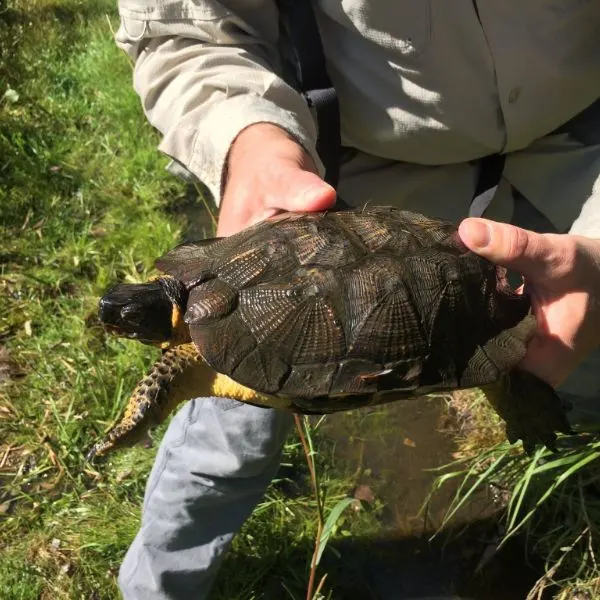
- Experience Level: Intermediate
- Family: Emydidae
- Scientific Name: Glyptemys insculpta
- Other Names: N/A
- Adult Size: 5.5 to 9 inches
- Life Span: 40 to 60 years
- Average Price Range: $250 to $500
- Conservation Status: Endangered
Wood turtles are another very intelligent, yet endangered turtle species. Once again, habitat loss is the main reason these turtles are sitting on the endangered animal list.
Meadows, forests, and other woodlands are where you’ll find Wood turtles. They also need access to a water source. Streams, ponds, mountain creeks, or floodplains work for this semi-aquatic turtle.
These turtles have carapaces that resemble carved wood. The scutes can be raised and have deep furrows and ridges, and are golden brown like polished, stained wood. The skin on these turtles is also brown, and usually has a reddish-orange tint found on the legs.
They will roam across the ground looking for food and mates, but they have to return to the water. While on their daily excursions, if they can’t find food, they have figured out how to make worms come to the surface.
Wood turtles will stomp and “dance” on the ground to emulate the sound of falling rain. Worms will rise to the surface, and the Wood turtle just served itself lunch.
Aside from worms, these turtles feed on insects, fish, crustaceans, mushrooms, berries, fruits, and plants.
Pond Sliders in Pennsylvania
These next two turtles are non-native species that have been introduced or escaped their enclosures and are now putting strain on native turtles. The Red Eared Slider, and the Yellow Belly Slider compete for habitat, basking spots, and food, and often push native turtles out of the habitat.
15. Red Eared Slider

- Experience level: Beginner
- Family: Emydidae
- Scientific Name: Trachemys scripta elegans
- Common Name: Pond slider, Red-eared terrapin, Water slider
- Average Adult Size: 6 – 8 inches
- Life Span: 20 to 40 years
- Average Price Range: approximately $30 to $100
- Conservation Status: Least concern
The Red Eared Slider is one of the most available species of pet turtle on the market. Babies are sold cheaply in pet stores across the country, and many end up being unsafely released into wild habitats by irresponsible or unprepared owners.
Red Eared Sliders have an olive green shell, with yellow, brown, green, and orange markings on their scutes. Young turtles are the most vibrant as these colors can fade as the turtle ages. Their skin is olive to dark brown with yellow stripes and bold, red patches just behind their eyes.
Any water will do for these turtles, aside from brackish and salt water, but they prefer slow moving rivers and lakes. Basking spots are equally important for these turtles. Often they will crowd each other, climb up in stacks, and run off other species in their quest to find the perfect basking spot.
The Red Eared Slider is a prolific breeder. Females can lay multiple clutches per season, and they reach sexual maturity in only 2 to 4 years.
Being omnivorous helps these turtles survive outside their native range as well. Red Eared Sliders will eat fish, crustaceans, tadpoles, insects, plants, and more.
16. Yellow Belly Slider

- Experience level: Beginner
- Family: Emydidae
- Scientific Name: Trachemys scripta scripta
- Other Names: Pond slider, Yellow slider
- Average Adult Size: 5 – 13 inches
- Life Span: 50 to 100 years
- Average Price Range: approximately $30 to $130
- Conservation Status: Least concern
The Yellow Belly Slider looks much like the previous non-native, except they have a bright yellow belly, as the name suggests, they also have yellow stripes on the skin, but these stripes are much wider. They also lack the red “ear” patches.
These turtles love the water but will come on land readily. In the water, they feed on plants, insects, fish, and other aquatic organisms.
If you have a turtle you can no longer care for, you may think you’re doing the right thing by letting it go into the wild, but you wouldn’t just set a dog or cat free in the wild would you? Of course not.
For whatever reason you can no longer care for a pet turtle, please try to find someone else who can take it for you, give it to a reptile rescue, or contact your local vet on what you should do. Releasing captive turtles can harm native species because they can spread disease, and become invasive, or the former pet may end up perishing.
FAQs
Can you own pet turtles in Pennsylvania?
Many of Pennsylvania’s native turtle species are threatened, endangered, and/or protected. In Pennsylvania it is illegal to own any of the following turtles;
– Blanding’s turtles
– Bog turtles
– Eastern Box turtles
– Northern Red-bellied Cooters
– Eastern Mud turtles
– Midland Painted turtles
– Spotted turtles
– Wood turtles
The remaining species found in Pennsylvania can lawfully be owned. Be sure to find a reputable turtle breeder instead of taking these turtles from the wild.
Wrapping up
So that wraps up our list of the 16 turtles in Pennsylvania. We’ve covered the Keystone State’s 14 native turtle species, many of which are threatened or endangered, as well as 2 non-native turtles. This list can be used as a field herping guide if you are exploring Pennsylvania.
If you’re considering getting one of these species as your next pet turtle, please check to see if it is legal to own your chosen species in Pennsylvania or other states.
If you enjoyed this list, please feel free to comment below! We love to hear from fellow turtle enthusiasts.
Other nearby states
- Turtles in Delaware
- Turtles in Maryland
- Turtles in New Jersey
- Turtles in New York
- Turtles in Ohio
- Turtles in West Virginia
